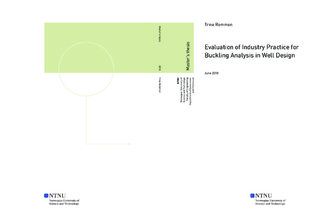| dc.description.abstract | The development of horizontal drilling technology have enabled the production of oil and gas from thin layers. With the development of shallow, horizontal subsea wells, new challenges arises. The occurrence of compressive forces affects horizontal reach and tubing movement. These challenges can be seen in direct relation to buckling. The consequences of buckling can be costly work-overs and even loss of integrity.
The integrity of a well construction is essential, and design factors are included in the stress analysis to ensure safe and profitable hydrocarbon recovery. The highest design factor is used for axial loads, as they are subject to the highest uncertainty. Exceeding the buckling limit can introduce local bending forces. The tubing will permanently deform, if yield strength is exceeded by triaxial stress due to buckling. Deformation of the tubing can lead to loss of drift, or even loss of integrity and discharge to the environment as a worst case scenario. A better understanding of buckling can reduce the risk of severe axial failures.
Compressive forces are introduced early in the completion process. When the tubing is lowered, the compressive forces are mainly induced by friction. The occurrence of compression and geometrical imperfections can buckle the string, and affect the limit of reach in horizontal wells. A model is therefore developed to predict buckling during tubing installation. The model is applied on a generic well design for a shallow subsea field to investigate the tubing integrity for producers and injectors.
Post installation, the tubing is anchored between the wellhead and the production packer. Cyclic temperature and pressure loads induces tubing movement. Initiation of buckling causes additional tubing movement. A second model is developed to evaluate load cases and ensure that buckling does not affect the well integrity.
Literature review show that preexisting industry standard buckling models were developed at a time without widespread use of digital calculation aids. Consequently, the models are developed by simplifying assumptions enabling use of only hand calculations. These models have further been implemented in industry software, and are still in use today, despite these simplifying assumptions.
The digital aids are rapidly developing, and this opens the possibility of a new buckling model with no simplifying assumptions. When the simulations matches a real scenario, the model becomes more reliable. This thesis is the first step of achieving this long-term objective. | |

